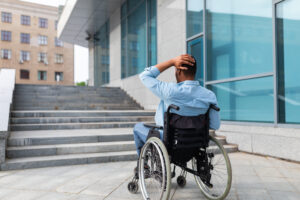Author: Sheri Denkensohn-Trott
It is hard to believe that July 26 marks the 33rd anniversary of the Americans with Disabilities Act (ADA). When I became a quadriplegic in 1983, passage of this landmark legislation was merely a hope. I couldn’t fathom that there would be legislation protecting my civil rights in employment, and especially public accommodations like restaurants, movie theaters, and the like. I’m grateful that laws such as the ADA establish and protect my rights. But, on the flipside, while the ADA has become part of our lexicon, adherence is far from established. Don’t get me wrong, there has been great progress, but in my opinion, we should be much further along than we are.
like restaurants, movie theaters, and the like. I’m grateful that laws such as the ADA establish and protect my rights. But, on the flipside, while the ADA has become part of our lexicon, adherence is far from established. Don’t get me wrong, there has been great progress, but in my opinion, we should be much further along than we are.
Some of the most fundamental tenets of the ADA cover accessibility within one’s own community. I live in an urban setting with many curb cuts, retail establishments, coffee shops, and other places that I can navigate to on my own. After 33 years you would think it would be a no-brainer for accessibility. While the transportation system (Metro) and paratransit systems are close to the best when it comes to accessibility, there are still glitches. And I am willing to accept those. What makes my blood boil is new construction that is not ADA compliant. I am referring to issues such as the height of  counters, door width, automatic door openers that are placed out of reach, unnecessary steps, and parking spaces that are improperly marked or do not have the requisite layout for a van with a ramp to open. Add to that, hotels with “accessible” rooms that are not accessible, and other amenities that do not meet ADA standards.
counters, door width, automatic door openers that are placed out of reach, unnecessary steps, and parking spaces that are improperly marked or do not have the requisite layout for a van with a ramp to open. Add to that, hotels with “accessible” rooms that are not accessible, and other amenities that do not meet ADA standards.
In addition, I deal with violations of the ADA daily. Individuals without hangtags or license plates parking in handicapped parking spaces, scooters and bikes left in the middle of a curb cut, and brand-new construction receiving certificates of occupancy despite blatant ADA violations. Because the ADA is structured as a law that requires a complaint to trigger enforcement, it is up to someone (like me) to act. Depending on the issue, that may mean calling a nonemergency police number to ticket a car that is illegally parked, attempting to amicably work with management of an establishment to lower a counter that is not accessible, eliminate unnecessary steps, or fix a ramp that is not graded to code. When results are not fruitful, it is necessary to report to the County about the violation and/or file a complaint with the Department of Justice. This takes energy and time. And sometimes I have the time and energy and follow through, and other times I’m worn down and tired and make the difficult decision to let it go in that instance. Even if a complaint is filed, there is no guarantee that enforcement will occur.
On the plus side, the pandemic created a necessity for remote work and individuals with disabilities who needed to have a system of working remotely because of their specific condition have more opportunities for employment. While the unemployment numbers remain high, there has been a slight increase in the disability employment percentages. Additionally, telemedicine and other technological developments are a significant benefit for individuals with disabilities. It is a relief to not have to travel to a medical appointment where in person presence is not required, and this may be especially true in rural areas where transportation and logistics for those with disabilities remains difficult.
With Diversity, Equity, and Inclusion initiatives being highlighted, the concept of accessibility and the needs of those who have disabilities are receiving more attention. This is especially true in the arts, where individuals with disabilities are being cast for roles of someone who has a disability instead of an able-bodied person being cast in that role. These gains cannot be taken for granted. There is progress.
the concept of accessibility and the needs of those who have disabilities are receiving more attention. This is especially true in the arts, where individuals with disabilities are being cast for roles of someone who has a disability instead of an able-bodied person being cast in that role. These gains cannot be taken for granted. There is progress.
Disability is not always apparent and there are many different types. This diversity within the disability community often makes it complex to form a coalition with similar goals. More recently, I’ve been pleased to be involved with advocacy efforts where members of different disability groups have come together to champion important issues such as airline access, caregivers being in short supply and underpaid, and equity in healthcare. This gives me hope that we can begin to utilize our power in numbers to attain legislative achievements.

What do I hope for in the coming years? Education on a broader range so that the basics of the ADA are followed. Fighting for our rights as individuals with disabilities, along with other nondisabled allies. Viewing accessibility as a benefit for all of society, not just those with disabilities. Bringing individuals to the table when policies, plans, and product development occurs instead of after-the-fact. Finally, fewer instances when I must fight a basic ADA violation. Thirty-three years later, I don’t think that’s too much to ask.

